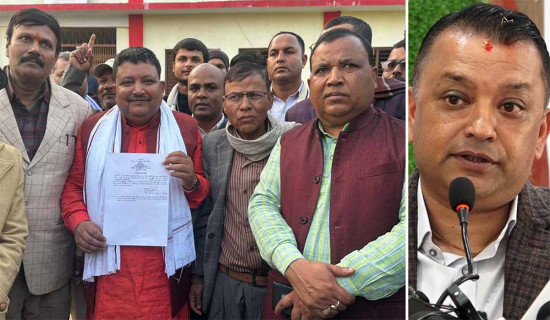- Wednesday, 21 January 2026
Jajarkot-Rukum Quake
Wake-up Call For Better Preparedness
On November 3, around midnight, the region of Jajarkot and Rukum in west Nepal experienced a significant earthquake, which had a magnitude of 6.4. The quake, which struck with a sudden and jolting force, left a trail of destruction in its wake. Reports of collapsed buildings, damaged infrastructure, and casualties quickly made headlines. The affected communities were plunged into chaos and despair as they grappled with the immediate aftermath of this seismic event. Sad to say but true, a landlocked nation nestled in the Himalayas, is no stranger to the wrath of Mother Nature. The country has a history of enduring powerful seismic activity due to its location along the tectonic boundary of the Indian and Eurasian plates. This geological reality has made Nepal particularly vulnerable to earthquakes, and the recent Jajarkot-Rukum earthquake serves as a sobering reminder that the next "big one" may be just around the corner.
The recent earthquake, though devastating, is relatively shallow, occurring closer to the Earth's surface, and is considered moderate in intensity. Nepal's geological vulnerability, stemming from the continuous convergence of the Indian and Eurasian plates colliding at a rate of 2 cm per year, holds the potential to create a subduction zone capable of generating powerful tremors. The accumulated stress along the tectonic boundary of the Indian and Eurasian plates was evident in historical events like the devastating 2015 Gorkha earthquake.
Potential precursor
This Jajarkot-Rukum earthquake transcends being a mere natural disaster; it serves as a clarion call for both Nepal and the global community. While the recent seismic event had a considerable impact, it is imperative to view it as a potential precursor to a more significant seismic occurrence. Despite this quake having a magnitude of 6.4, seismologists have consistently warned of an impending threat, anticipating a magnitude of 7.5 or higher. Each incremental rise in earthquake magnitude releases 32 times more energy. A study by the United States Geological Survey (USGS) reveals that Nepal is susceptible to earthquakes surpassing 7.5 along the Main Himalayan Thrust, the tectonic boundary of the Indian and Eurasian plates.
The historical record further underscores this vulnerability, with Nepal experiencing several devastating earthquakes of magnitudes exceeding 7.5 in 1255, 1408, 1833, 1934, and 2015. In the aftermath of the quake, a news report suggests that billions of rupees' worth of property were reduced to rubble, with 35,455 houses reported as partially damaged and 26,557 completely destroyed. This outcome was not surprising, given that most damaged houses in the region were non-engineered, unsafe constructions built with stones and mud, detached from codal provisions, and highly susceptible to tremors. Furthermore, there appeared to be minimal preparations in the region based on lessons from past earthquakes. The earthquake has sent a strong and clear message: the region needs to remain alert and well-prepared.
Enforcing stringent building codes and retrofitting existing structures to comply with these codes are primary measures to reduce the impact of future earthquakes. While the Nepal government has ratified a new building code, it still lags far behind in the cutting-edge standards implemented in other nations with high seismicity risk and hampered by implementation issues. Public awareness and education about earthquake preparedness are equally vital. The population should be educated about appropriate actions during an earthquake, evacuation plans, and the importance of emergency supplies. Schools, community organisations, and government initiatives play a crucial role in disseminating this crucial information.
The region consistently contends with frequent seismic activity, underscoring the urgent imperative for preparedness and resilience. The necessity for preparedness at both individual and societal levels can never be overstated. As Nepal undergoes the process of rebuilding and recovery, it is vital to recognise the ongoing threat of a more substantial quake. Collaborative efforts involving communities, government agencies at all levels and international organisations are crucial for developing and implementing strategies to mitigate the impact of future earthquakes.
Stark reminder
In sum, the recent earthquake in Jajarkot-Rukum serves as a stark reminder of Nepal's vulnerability to seismic activity. This event is a call to action for all stakeholders, from government bodies to individuals, to prioritise earthquake preparedness and resilience. While the timing of the next significant earthquake remains unpredictable, our level of preparedness is within our control. Nepal must adopt a comprehensive approach, leveraging knowledge from research and academia, strengthening building codes, implementing robust enforcement mechanisms, refining design guidelines, and prioritising capacity building for local structural engineers.
Public education and awareness, facilitated through various media channels, including digital platforms, must play a pivotal role in fostering a culture of earthquake preparedness. Through these proactive measures and a steadfast commitment to seismic resilience, Nepal can confidently move into the future, ensuring the safety and well-being of its people and the durability of its infrastructure.
(Practicing structural engineer, Dr. Puri holds a PhD from Tokyo University and a postdoc from the University of Illinois at Urbana-Champaign, USA.)
















